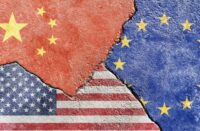On January 6, U.S. National Security Adviser Jake Sullivan and other senior U.S. officials convened a meeting with Indian Prime Minister Narendra Modi, External Affairs Minister Dr. S. Jaishankar, and Ajit Doval, Sullivan’s Indian counterpart. The two parties discussed advancements in key sectors, including the Initiative on Critical and Emerging Technologies (iCET).
This visit came shortly before the transition from the Biden administration to a new Trump era. The meeting concluded with the revelation of significant U.S. policy amendments that will bolster U.S.-India relations. These policy updates include changes to U.S. missile export control regulations under the Missile Technology Control Regime (MTCR). This move is set to enhance U.S.-India commercial space collaboration.
Sullivan also declared the U.S.’s plans to finalize the removal of Indian nuclear entities from restricted list, a move that will foster civil nuclear collaboration and clean energy supply chains. This move has been a long-standing barrier to nuclear cooperation between the two nations and is expected to take effect by January 19.
Sullivan emphasized that the next decade will see the India-U.S. partnership reach unprecedented heights. Both visits were essential in facilitating a seamless transition into the new Trump era, while highlighting the deep-rooted and ever-evolving nature of U.S.-India ties.
The visits were crucial in the context of India’s civil nuclear program, the future of U.S.-India relations, and the recent tension between the two countries. At present, the main obstacle to bilateral civil nuclear collaboration is the U.S. Atomic Energy Act. This act allows for U.S. nuclear vendors to export equipment to other countries under specific safeguards, but it prohibits them from jointly manufacturing any nuclear equipment or performing nuclear design work in designated countries, including India.
Sullivan’s announcement could open the door for joint production of nuclear elements for atomic power projects planned in India using U.S. atomic reactors. This is particularly significant as India seeks to position itself as a reliable and affordable location for manufacturing nuclear reactors, especially small modular reactors (SMRs).
Moreover, Sullivan’s visit demonstrated Washington’s commitment to deepen and speed up bilateral cooperation in other critical sectors, such as advanced technologies. This commitment was further highlighted with the announcement of collaboration on the co-production of U.S. sonobuoys for the Indian Navy.
During their visits, Sullivan and Jaishankar also proved their determination to prevent unforeseen crises from derailing U.S.-India relations. These visits were timely and critical due to several incidents of friction in the past few months.
Going forward, while U.S.-India relations may face certain challenges with every U.S. administration, some experts argue that the impact of trade disagreements under the new Trump era is likely to be relatively significant for India. However, the strong strategic alignment between the two nations might temper Trump’s tendencies for imposing tariffs.
While Trump’s transactional approach to foreign policy might bring certain benefits for India, it could also result in different approaches to cooperation in sectors like defense. Washington’s potential demands for India to increase defense imports, rather than India’s preferred projects involving technology transfer, could affect the benefits India desires from its ties with the United States.
As both countries collaborate on building resilient supply chains, cooperation on establishing a global governance framework, including for AI and global commons, in addition to collaborating for regional security, is likely to be a key focus area moving forward.




